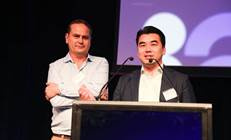The recent changes within the CIOs of Australia’s major financial institutions have prompted discussion about the future role of the chief information officer.

Some say the role of the CIO is at risk. There’s talk the new kids on the block, the chief digital officer and chief data officer, are eating into the traditional scope of the CIO and putting the function at risk.
The sense is that one day, the role will be reallocated in the organisation and won’t need to exist at the C-level. In fact, just recently one large organisation in Australia admitted that they would not be replacing their CIO who had recently resigned. So, does this signal the end of the CIO role?
I disagree.
CIOs will be around for many years to come, and I don’t see any chance of the role being eliminated.
I am of the view that the CIO – even if the term does morph over time into something else – will become increasingly important to the future success of any organisation. But the CIO of the future will not be focusing on the same things as today.
Those of you old enough may remember it was only in the very late ’80s and early ‘90s that the term CIO came into being. Before that senior IT leaders were called IT managers and before that MIS managers, and before even that EDP managers.
EDP managers were all about the new forms of data processing that mainframe computers enabled. MIS managers came about when organisations realised the importance of management information to help with business decision making.
The term IT manager came into being as a way of showing how computing and information came together into the broader realm of information technology. Eventually the term CIO became commonplace as organisations realised IT was becoming pervasive and affecting every part of the business, and that they needed to elevate the position to a seat at the executive table.
We are still on this journey, and the role of the CIO will continue to change and evolve.
The convergence of social, mobile, analytics and cloud (SMAC) has inextricably changed the environment that the CIO is meant to work within.
The social and mobile part of SMAC has in many respects led to the rise of the chief digital officer. This role deals with how technology and the channels through which organisations interact with their customers is affecting the customer experience, an issue that many CIOs focus on today.
The analytics element of SMAC has resulted in the rise of chief data officers, who turn vast amounts of information into insights on past and possible future behaviours. Again, in many organisations, this role now sits in the business when the function previously sat in IT.
The cloud aspect of SMAC has not yet spawned another C-level position, so for now this remains a key part of the CIO’s role.
While losing some aspects of traditional focus areas, there are however new functions the CIO of the future will need to add to their remit.
Aside from keeping the technology environment reliable and secure, this new breed of CIO will focus on five key areas:
- Business strategy and innovation. The CIO of the future will be just as accountable as any other group executive for the business strategy of the organisation, with a large part of their contribution around how best to innovate.
- Analysis and application of new and emerging technologies. As technology continues to rapidly change and reinvent itself, it is becoming even more crucial that an executive exists who is accountable for evaluating technology trends to determine what will deliver real value to customers and the organisation.
- Leveraging of cloud and utility computing. Cloud computing is probably the biggest change to the domain of the traditional CIO or IT manager. The infrastructure domain of the future will be a mix of onsite, private onshore, private offshore and public cloud computing. The CIO of the future will need to change the way the organisation thinks about the use of compute power, navigate the myriad of cloud options available, and build the capability.
- Partner relationship management. In the age of outsourcing, the CIO of the future will be less accountable for managing day-to-day delivery teams. The CIO will make arrangements with specialists for most of the detailed design, build, run and management of functions. The tasks remaining in-house will be strategy, planning, financial management and sourcing. Everything else will be about managing partnerships, both externally and with internal business units, like marketing and analytics.
- Simplification and reduction in complexity. For larger and older enterprises a key focus area for the CIO will be reducing complexity in the organisation. CIOs will become the champions of simplification. In some cases, IT probably helped to create a lot of the complexity and legacy in the first place and will be best placed to understand how to leverage technology to simplify and streamline the business.
The timing for the evolution of the CIO function will be different for many organisations and will depend on their size, complexity, current operating model and even the politics in the boardroom.
Eventually though, as the roles of chief marketing officer, chief digital officer and chief data officer become more embedded and sophisticated in the use of technology in these domains, pressure will be on the CIO to focus on adapting and adding value in new ways.
The title of CIO may even change over time. It may incorporate new terms like innovation, utility and simplification just as it morphed from EDP to MIS to IT to CIO. A rose by any other name, and all that.
Importantly, CEOs will need to ensure they are hiring CIOs willing and able to adapt to the evolution of the role. Candidates will need to embrace change and have the skills and discernment required to make the right recommendations.
The CIO of the future will likely be less technical than in the past. They will need to be able to stand on an equal footing with other business executives in developing the business strategy and able to build partnerships internally and externally to deliver technology-enabled outcomes while being the champions of innovation and simplification.
Not quite the same as today, but still sounds like a fun gig to me.
Jeff Jacobs is a Sydney-based technology executive and IT consultant with over 25 years experience in senior IT positions with AMP, Zurich, CBA and most recently as the CTO of Westpac.




_(20).jpg&h=140&w=231&c=1&s=0)

_(22).jpg&h=140&w=231&c=1&s=0)



_(26).jpg&w=100&c=1&s=0)

 iTnews Executive Retreat - Security Leaders Edition
iTnews Executive Retreat - Security Leaders Edition












_(1).jpg&h=140&w=231&c=1&s=0)



